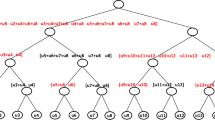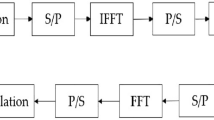Abstract
Spatial modulation orthogonal frequency division multiplexing (SM-OFDM) system has been recently proposed as an alternative for multiple-input multiple-output (MIMO)-OFDM systems to increase spectral efficiency by keeping a low-complexity implementation. In the literature, SM-OFDM systems assume a perfect channel state information (P-CSI) available at the receiver for coherent detection and the channel estimation problem is not considered. It is clear that the channel estimation is a critical issue on the performance of SM-OFDM systems. In this paper, a frame structure where pilot symbols are typically interspersed with data symbols among the sub-carriers to aid the channel estimation is considered. Then the pilot symbol aided channel estimation (PSA-CE) technique with different interpolations is proposed for the SM-OFDM systems. It is shown that in the proposed PSA-CE, equidistantly spaced pilot symbols allow to reconstruct the channel response by means of interpolation if the spacing of the pilots is sufficiently close to satisfy the sampling theorem. Linear, nearest neighbor, piecewise cubic Hermite and the low-pass interpolations are investigated to explore trade-off between complexity and performances. We show that the low pass interpolator yields better performance than the other interpolation techniques for selected cases such as higher order modulations. The results validate the potential of the proposed PSA-CE estimation applying to SM-OFDM systems.











Similar content being viewed by others
References
Blcskei, H. (2006). MIMO-OFDM wireless systems: Basics, perspectives, and challenges. IEEE Wireless Communications, 13(4), 31–37.
Chiani, M., Win, M. Z., & Zanella, A. (2003). On the capacity of spatially correlated MIMO Rayleigh-fading channels. IEEE Transactions on Information Theory, 49(10), 2363–2371.
Shiu, D. S., Foschini, G. J., Gans, M. J., & Kahn, J. M. (2000). Fading correlation and its effect on the capacity of multielement antenna systems. IEEE Transactions on Communications, 48(3), 502–513.
Mesleh, R., Haas, H., Ahn, C. W., & Yun, S. (2006, October). Spatial modulation-a new low complexity spectral efficiency enhancing technique. In processing of the IEEE First International Conference on Communications and Networking in China (ChinaCom’06), (pp. 1–5), (Oct 2006).
Renzo, M. D., Haas, H., & Grant, P. M. (2011). Spatial modulation for multiple-antenna wireless systems: A survey. IEEE Communications Magazine, 49(12), 182–191.
Yang, P., Xiao, Y., Zhou, B., & Li, S. (2011, August). Initial performance evaluation of spatial modulation OFDM in LTE-based systems. In processing of the IEEE 6th International ICST Conference on Communications and Networking in China (CHINACOM), (pp. 102–107), (August 2011).
Basar, E., Aygolu, U., Panayirci, E., & Poor, H. V. (2013). Orthogonal frequency division multiplexing with index modulation. IEEE Transactions on Signal Processing, 61(22), 5536–5549.
Jeganathan, J., Ghrayeb, A., & Szczecinski, L. (2008). Spatial modulation: Optimal detection and performance analysis. IEEE Communications Letters, 12(8), 545–547.
Mesleh, R., Ganesan, S., & Haas, H. (2007). Impact of channel imperfections on spatial modulation OFDM. In Personal, IEEE 18th International Symposium on Indoor and Mobile Radio Communications (PIMRC 2007), (pp. 1–5). (Sept. 2007).
Acar, Y., Doğan, H., & Panayirci, E. (2015). On channel estimation for spatial modulated systems over time-varying channels. Digital Signal Processing, 37, 43–52.
Wu, X., Claussen, H., Di Renzo, M., & Haas, H. (2014). Channel estimation for spatial modulation. IEEE Transactions on Communications, 62(12), 4362–4372.
Yalcin, M., Akan, A., & Doğan, H. (2012). Low-complexity channel estimation for OFDM systems in high-mobility fading channels. Turkish Journal of Electrical Engineering & Computer Sciences, 20(4), 583–592.
Andrews, J. G., Ghosh, A., & Muhamed, R. (2007). Fundamentals of WiMAX: understanding broadband wireless networking. Pearson Education.
Dahlman, E., Parkvall, S., & Skold, J. (2013). 4G: LTE/LTE-advanced for mobile broadband. Cambridge: Academic press.
Coleri, S., Ergen, M., Puri, A., & Bahai, A. (2002). Channel estimation techniques based on pilot arrangement in OFDM systems. IEEE Transactions on Broadcasting, 48(3), 223–229.
Doğan, H. (2016). On detection in MIMO-OFDM systems over highly mobile wireless channels. Wireless Personal Communications, 86(2), 683–704.
Wu, Y., Zhao, Y., & Li, D. (2012). Channel estimation for pilot-aided OFDM systems in single frequency network. Wireless Personal Communications, 62(1), 227–245.
Colieri, S., Ergen, M., Puri, A., & Bahai, A. (2002). A study of channel estimation in OFDM systems. Proceedings the IEEE 56th Vehicular Technology Conference (VTC2002-Fall), (pp. 894–898), (2011).
Dyer, S. A., & He, X. (2001). Cubic-spline interpolation: Part 2. IEEE Instrumentation & Measurement Magazine, 4(2), 34–36.
Kahaner, D., Moler, C., & Nash, S. (1989). Numerical methods and software (p. 1). Englewood Cliffs: Prentice Hall.
Fritsch, F. N., & Carlson, R. E. (1980). Monotone piecewise cubic interpolation. SIAM Journal on Numerical Analysis, 17(2), 238–246.
Moler, C. B. (2008). Numerical Computing with MATLAB: Revised Reprint. Siam.
Rinne, J., & Renfors, M. (1996). Pilot spacing in orthogonal frequency division multiplexing systems on practical channels. IEEE Transactions on Consumer Electronics, 42(4), 959–962.
Patzold, M. (2003). Mobile fading channels. Hoboken: Wiley.
Xia, B., & Wang, J. (2005). Effect of channel-estimation error on QAM systems with antenna diversity. IEEE Transactions on Communications, 53(3), 481–488.
Cirpan, H. A., Panayirci, E., & Doğan, H. (2006). Nondata-aided channel estimation for OFDM systems with space-frequency transmit diversity. IEEE Transactions on Vehicular Technology, 55(2), 449–457.
Di Renzo, M., Haas, H., Ghrayeb, A., Sugiura, S., & Hanzo, L. (2014). Spatial modulation for generalized MIMO: Challenges, opportunities, and implementation. Proceedings of the IEEE, 102(1), 56–103.
Author information
Authors and Affiliations
Corresponding author
Additional information
This work is supported in part by the Turkish Scientific and Technical Research Institute(TUBITAK) under Grant 114E011.
Rights and permissions
About this article
Cite this article
Acar, Y., Doğan, H. & Panayirci, E. Pilot Symbol Aided Channel Estimation for Spatial Modulation-OFDM Systems and its Performance Analysis with Different Types of Interpolations. Wireless Pers Commun 94, 1387–1404 (2017). https://doi.org/10.1007/s11277-016-3687-9
Published:
Issue Date:
DOI: https://doi.org/10.1007/s11277-016-3687-9




